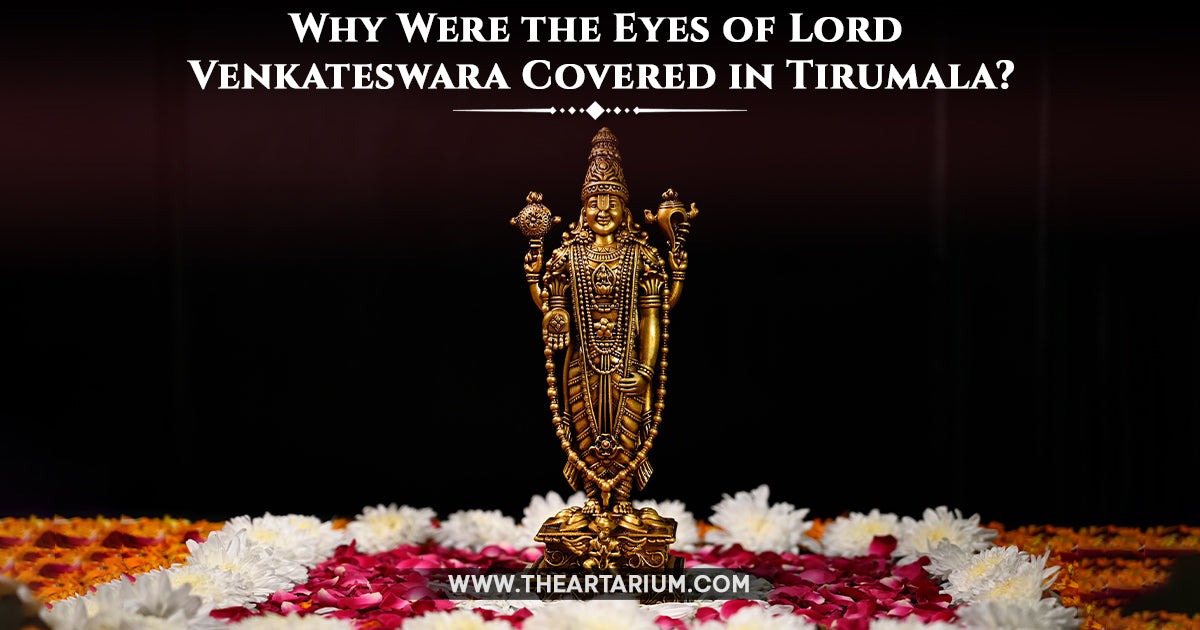
4 minute read
Why Were the Eyes of Lord Venkateswara Covered in Tirumala? – The Artarium
The holy shrine of Lord Venkateswara in Tirumala is a place of immense significance for devotees across the world. The temple, perched atop the seven hills of Tirumala in Andhra Pradesh, India, is renowned not only for its spiritual ambiance but also for its rich history and unique rituals. One of the intriguing aspects of this revered temple is the practice of covering the eyes of Lord Venkateswara, also known as Lord Balaji, during certain times. This ritual, deeply embedded in tradition and mythology, has captivated the curiosity of many. Let us explore the reasons and significance behind this unique practice.
Historical and Mythological Context
The tradition of covering the eyes of Lord Venkateswara can be traced back to ancient myths and legends that form the cornerstone of the temple’s history. According to popular belief, the practice is linked to a significant event in the divine history of the deity.
The story goes that once, during a time of great distress, the great sage and devotee of Lord Vishnu, Venkateswara, sought to conceal his divine form from the eyes of ordinary beings. This act was meant to shield the deity’s divine beauty and magnificence from those who were not yet prepared to perceive it. The covering of the eyes was symbolic of maintaining the sanctity and mystery surrounding the divine form.
Symbolism of the Ritual
The ritual of covering the eyes of Lord Venkateswara is laden with profound symbolism. Here are some key aspects:
Mystery and Reverence: Covering the eyes of the deity serves as a symbolic gesture to maintain the mystery and reverence surrounding the divine form. It signifies that the true essence of divinity is beyond human perception and cannot be fully grasped by mere sight.
Focus on Devotion: This practice encourages devotees to shift their focus from the physical appearance of the deity to the inner essence of worship and devotion. It underscores the importance of faith and inner connection over external manifestations.
Preservation of Sanctity: By covering the eyes, the temple authorities ensure that the deity’s form remains untouched by the imperfections of the material world. It is a way to preserve the sanctity and purity of the divine image.
The Ritual Process
The process of covering the eyes of Lord Venkateswara is conducted with great reverence and precision. The ritual is usually performed during specific times or occasions, often aligned with certain lunar or solar events. Here is a glimpse into how the ritual is carried out:
Preparation: The covering is done with special fabrics or materials that are carefully chosen for their purity. The process is accompanied by prayers and hymns to invoke the blessings of the deity.
Timing: The covering is typically performed at particular times of the day or during specific rituals. The timing is chosen based on astrological and religious considerations.
Ceremony: The ceremony involves a series of rituals and offerings, during which the deity’s eyes are gently covered. The process is carried out by the temple priests with utmost care and devotion.
Devotees' Perspective
For devotees, the covering of Lord Venkateswara’s eyes is not seen as a loss but as a profound reminder of the spiritual journey. It reinforces the belief that the divine is not limited to physical sight but is experienced through faith, devotion, and inner realization.
Many devotees believe that this ritual also provides an opportunity for them to engage in deeper spiritual practices and introspection. It serves as a reminder of the divine’s transcendental nature and encourages them to seek a more profound connection with the deity.
Conclusion
The tradition of covering the eyes of Lord Venkateswara in the Tirumala temple is a unique practice with deep-rooted historical, mythological, and symbolic significance. It is a reminder of the divine mystery that surrounds the deity and encourages devotees to transcend the limitations of physical sight to experience a more profound spiritual connection. This practice not only preserves the sanctity of the divine form but also enhances the overall spiritual experience for the millions of devotees who visit the temple each year. As we ponder the reasons behind this ritual, we gain a deeper appreciation for the intricate tapestry of tradition and spirituality that defines the Tirumala shrine.
Feel free to reach out if you have any more questions or need further details about other aspects of this revered temple!

